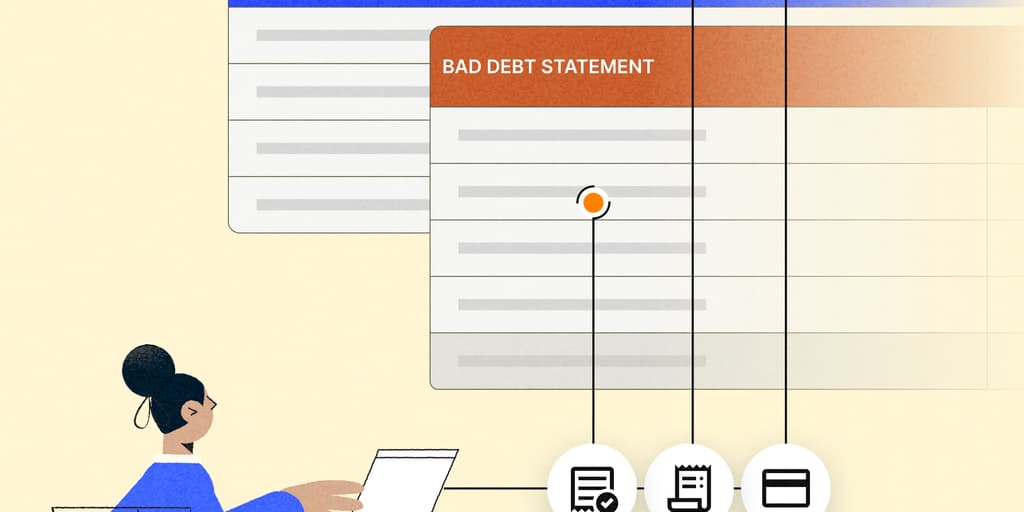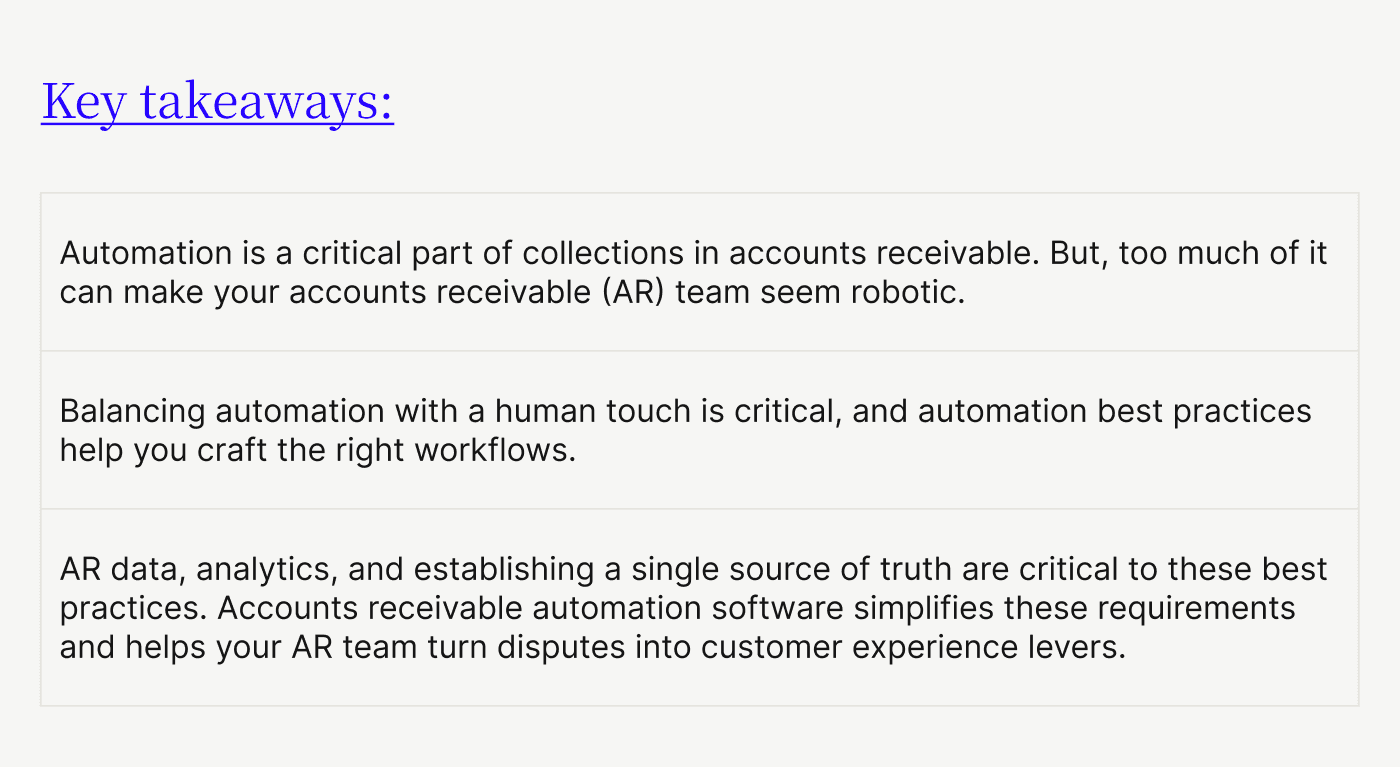
How to Solve Complex Accounts Receivable Disputes with These 5 Automation Best Practices
- 10 min read
We interviewed Versapay's Director of Financial Operations to understand how accounts receivable teams can integrate automation into complex dispute resolution processes.
Here are her 5 best practices for striking a balance between automation and personalized dispute resolution needs.


Automation has revolutionized accounts receivable processes, significantly reducing average dispute resolution timelines. However, the prevailing narrative often focuses on automation's ability to solve simple disputes, overlooking its potential in more complex scenarios.
Elena Ma, Director of Financial Operations at Versapay, challenges this limited view. "I think automation does not have to replace the human touch, but rather it can help enhance it," she says. "You want to strike a balance between automation and ease of connection when using it to solve complex disputes."
By strategically augmenting manual workflows, AR teams can not only expedite resolving intricate issues but also leverage these interactions to enhance the overall customer experience.
In this article, we'll explore five best practices—based on Elena's experience—for integrating automation into complex dispute resolution processes.
Table of contents
Best practice 1: Use automation to improve communication
Effective communication is critical to successfully resolving complex disputes. Automation helps accounts receivable teams enhance communication, ensuring all parties stay informed and engaged throughout the resolution journey.
A crucial first step is implementing a centralized collections platform that tracks customer data and activities—like account statuses, open invoices, and payment details—which offers a single source of truth for all stakeholders. Elena offers an example of how she uses this type of automation solution to ease communication.
"In our Collaborative AR platform, you're able to have both internal and external conversations on the same issue," she says. "You can post an answer just to internal teams and you can also post updates that face the customer."
This centralized system is augmented with automated features like payment reminders and invoice status notifications. "The automated payment reminders are very helpful, and I think they address the majority of the issue," she says. "But when they keep going and they're not answered, the system can tell you when something was delivered and if your reminder has been opened or not."
This data can help accounts receivable teams tailor customer communications. Wholesale distributor, Gulf Coast Panama Jack, is an example of the impact automated payment reminders can have on days sales outstanding (DSO), a core metric directly influenced by dispute resolution times. The company saves 20 hours every week and reduced DSO by 67% after introducing automation to its invoice processing and cash application workflows.
And these tangible improvements don't account for better internal communication. A centralized platform automatically brings relevant internal teams, like sales, into the loop. This collaborative approach, enabled by automation, is essential for addressing complex disputes that need input from multiple departments.
Best practice 2: Lean on self-service to offer transparency
Self-service capabilities are a powerful tool that can significantly speed up dispute resolution while freeing up valuable time for your AR team. By offering customers the ability to access information and resolve issues at their own pace, you not only enhance transparency but also automatically prioritize the most critical issues for human intervention.
"You want to empower your clients to self-serve and resolve issues when they need it," Elena says. "We could be working in different time zones where perhaps when I need an answer, the other party is not available at those hours."
Effective self-service tools can include detailed account statements, invoice history, payment history, and comprehensive knowledge bases that address common questions. "I think the availability of reporting is critical," Elena says. "A lot of the time you get the question about an invoice like 'what is this charge?' or 'why am I charged this much?' Empowering your customers to have the reporting so that there is transparency solves these issues."
These self-service features create a win-win situation, Elena notes. Customers resolve simple issues quickly while your AR team has more time to focus on resolving complicated ones. "They're [your AR team] able to address it with a lot more attention and with a lot more focus on the customer."
TireHub followed this advice and empowered its customers to self-serve. Not only did its customers experience and enjoy the increased transparency, but TireHub recovered 200 hours for its accounts receivable team while decreasing AR contractor headcount.
Best practice 3: Use analytics to preempt lengthy dispute timelines
Centralizing accounts receivable data creates compounding positive effects that can be hard to comprehend, at first. For instance, North Atlantic International automated its AR processes (including collections) and unlocked $10 million in additional revenue.
While a lot of that new revenue appeared due to installing advanced prepayment functionality, a good portion emerged from the ability to analyze customer credit, revise credit policies, and gain visibility over different billing processes.
“We’re able to open up our view of who we can give business to,” says Anthony Mestroni, CEO, North Atlantic International. “And we’ve been able to open our doors to a lot, especially to transport companies.”
Elena notes that tracking standard collections metrics like DSO and CEI is important—but mapping them to the type of customer accounts before initiating manual intervention is critical. "For high dollar value accounts, you would want to introduce a human a little bit earlier on versus a low dollar value one," she says. "You can allow it to age a bit more before it becomes a concern."
Additionally, monitoring recurring dispute types helps you identify whether issues are simple, like incorrect quantities, or complex, such as line-item level disputes with discount values. Ultimately, giving customers transparency into their account statuses does more to reduce overdue payments than anything else.
"If your client understands what they're being invoiced for and how and why, that in itself largely eliminates the need for a dispute," Elena says. Transparency backed with the right accounts receivable analytics further reduces disputes, helping you preempt issues.
Best practice 4: Map human escalation workflows
Complex disputes often require human intervention. Mapping out effective escalation workflows ensures that the right people are involved at the right time, leading to faster and more satisfactory resolutions.
Elena offers an example of human intervention. "If your payment reminders are not producing results, you have to introduce a human touch to make sure there aren't any customer concerns present with other teams that are preventing this invoice from getting paid," she says.
One way of figuring out the right points for human intervention is to observe historical dispute types. Another is to implement triggered internal communication alerts for certain types of disputes.
For example, automatically alerting sales when a customer disputes contract terms ensures that all relevant parties are informed and can contribute to the resolution. Over time, these alerts and escalation workflows can be refined based on gathered dispute-related data, continuously improving the efficiency and effectiveness of your dispute resolution process.
Best practice 5: Emphasize the human touch with your AR team
Automation, when taken to an excess, can make your accounts receivable team seem faceless. Balancing automation with personalized communication ensures that customers feel valued and understood.
"The empathetic approach is important," Elena says. "It's important to keep in mind that both sides of the dispute are working towards the same goal. We both want to get this invoice paid, we both want to make sure that the services keep flowing uninterrupted."
To prevent your AR team from seeming faceless, remind your staff to communicate effectively. "Just staying in touch and I think providing reassurance that a customer is not forgotten [is crucial]," Elena says. "Somebody's working on that issue and we are going to get them answers."
Transparency about which portions of your collections process are automated and which are not can enhance customer trust, she adds. "If there is a need for a dispute, just make it easy for them to reach out to a human, and then you make sure that the human who's working with them stays on top of updates," Elena says.
By being open about your dispute resolution processes, you demonstrate that you're mindful of the customer experience, even as you use automation to improve collection efficiency.
Speed up collections with Versapay's accounts receivable automation platform
Automation has plenty to offer when resolving complex disputes. However, maintaining a balance between technology and a human touch is critical. The right software plays a critical role in this regard. Versapay's Accounts Receivable Efficiency Suite offers a comprehensive set of tools to transform your AR process while smoothing communication.
For instance, Sharp Canada implemented our Collaborative AR software to streamline payment processing and help customers self-serve simple needs. Sharp and our customers get:
A single source of truth for customer data that ensures all team members have access to up-to-date and accurate information, reducing disputes arising from data discrepancies.
Customer adoption reports with insights into how clients use the platform, helping you estimate ROI quickly.
Automated, customizable workflows that allow customers to escalate complex issues to AR team members.
Real-time communications that keep all parties informed throughout the dispute resolution process, building trust and allowing for quicker resolutions.
Learn more about how Versapay streamlines payment acceptance and brings you and your customers on the same page through collaboration.
About the author

Vivek Shankar
Vivek Shankar specializes in content for fintech and financial services companies. He has a Bachelor's degree in Mechanical Engineering from Ohio State University and previously worked in the financial services sector for JP Morgan Chase, Royal Bank of Scotland, and Freddie Mac. Vivek also covers the institutional FX markets for trade publications eForex and FX Algo News. Check out his LinkedIn profile.
Dispute and Deduction Management
Learn how automation and collaboration lets you track and resolve disputes faster.

